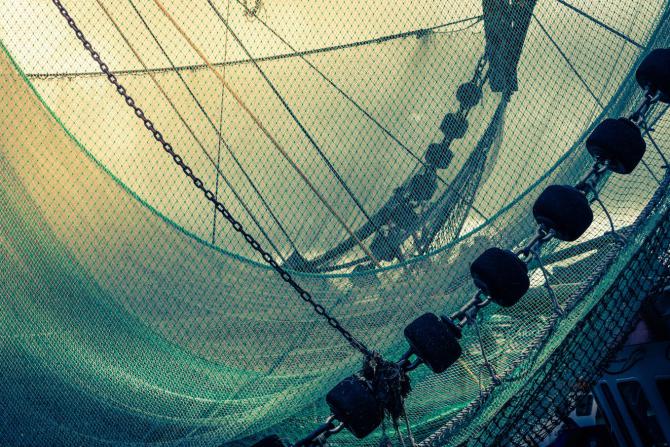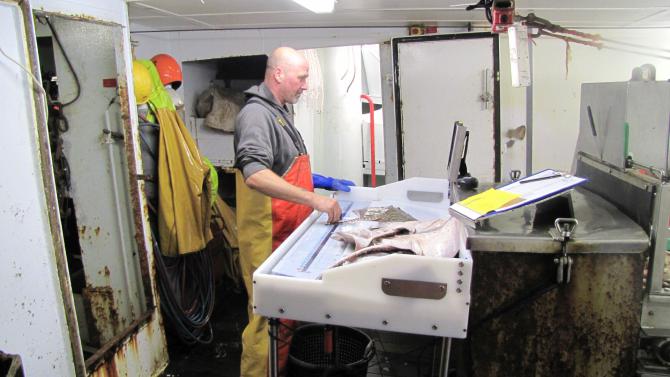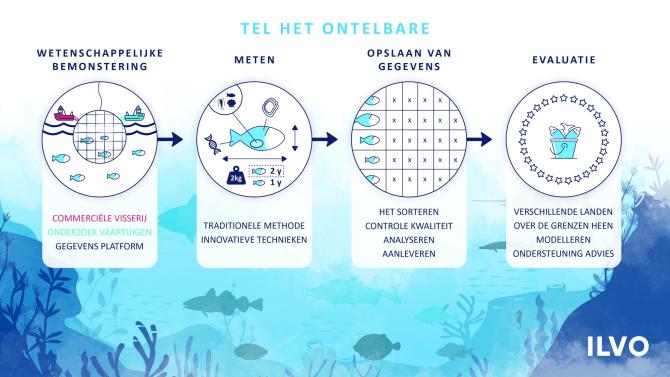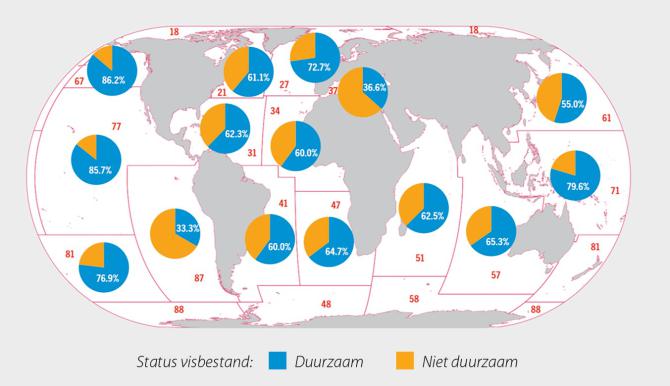In the media Fisheries data and the state of our fish stocks
Fish is healthy, we know. But what about the health of our fish stocks? For decades, fisheries scientists have warned that many fish stocks are being fished too hard. Sometimes the advice has been heeded, other times not. Entire fisheries have collapsed - as happened with the North Sea herring fishery in the late 1970s and across the Atlantic with the Great Banks cod fishery in the early 1990s. Fortunately, some fish stocks have been able to recover because of reduced fishing in recent years. So say scientists based on thousands of data they collect and analyze. Fishermen are an important "partner in science" in this effort.
How do we know how many fish swim in the sea?
No advice possible without data
When scientists make predictions about the condition of a fish stock or the marine ecosystem, they need data. If there is no data, there is no advice and policy cannot make informed decisions. Collecting data on fisheries and the marine ecosystem may sound simple, but it is not. Fish do not respect boundaries, making international coordination critical. Working with colleagues from other countries gives scientists a better picture of what is happening to fish populations and to the marine ecosystem in general. How different European countries collect, manage and make available this data on fisheries and marine ecosystems is governed by the European Data Collection Framework EC Regulation 2017/1004. This framework covers biological, environmental, economic and social data. Europe provides financial support for this data collection.

Sea-going observers
It is impossible to count every fish in the sea. So fisheries scientists turn to three main sources for data collection: commercial fishing vessels, research vessels and the ports where fish are landed. Each country has sea-going observers who travel monthly aboard fishing vessels or to fishing ports to take samples of landed fish. They always collect the same biological data: length, sex, weight and age of individual fish. Previously done with pen and paper, today there are electronic measuring boards, artificial intelligence and other innovative techniques such as sensors and DNA to enhance data collection. The deployment of these technical tools stems from the need to improve data quality and move from fishery advice on individual stocks, to advice on entire ecosystems.
To complement data collection from commercial vessels, two scientific surveys are also being conducted. The first survey continues in the southern North Sea with the Belgica (cooperation ODNature) and focuses, among other things, on stock surveys of plaice and sole. The second survey is carried out with the Simon Stevin (collaboration with VLIZ) in the Belgian coastal waters to determine the number of juvenile flatfish (mainly dab, plaice, sole, turbot, brill and shrimps).
The vessel as a data collector
Despite these new techniques, data collection at sea would not be possible without the help and cooperation of fishermen and the fishing industry. The number of sea-going observers is limited, as is the number of vessels they can go to sea with (e.g., due to lack of space). This limits data collection to only a fraction of the fishing fleet. And deploying additional people to collect more data to achieve greater coverage of the fleet requires (too) large an investment. Because the fisherman themselves also recognize the importance of more data and making it available more quickly, scientists and fishermen have joined forces in recent years. They started several fisheries-science partnerships that focus on the fishing vessel as a platform for data collection. Self-sampling can also significantly reduce the high cost of scientific activities. Self-sampling involves the fisherman in scientific sampling and new technologies (e.g., sensors, cameras). Admittedly, this requires such input of data actively collected by the industry that they inspire the necessary confidence from both industry and science.
National quality control
Thousands of data on fish in different marine regions have been meticulously collected. Time for scientists to process the available data with mathematical models. This will give them insight into the development of fish populations and the influence of fishing on them over time. Again, quality control by the national institutes will follow first.
ICES translates data into scientific advice
Next up is ICES, or the International Council for the Exploration of the Sea. This body coordinates the combined flow of data from all member states, including Belgium, to carry out fish stock estimates. As one of the European scientific fisheries institutes, ILVO participates in these ICES meetings. ICES working groups include scientists from countries that fish for a specific fish stock in the Northeast Atlantic and the Baltic Sea. ICES's role is to provide scientific advice on sustainable fisheries, based on the principles laid down in international agreements. Advice is based on population/biomass estimates of fish stocks but also on catch forecasts for the coming year at different levels of fishing intensity (scenarios).

European commission translates advice into fish quotas
An independent review process verifies the final outcome of the working groups and allows ICES to submit advice to the European Commission. The European Commission then has this advice thoroughly reviewed by the Scientific, Technical and Economic Committee for Fisheries (STECF). And it translates it into proposals for catch limits per fish stock, also known as TAC or Total Allowable Catch. Thus, the collection of data from each of the European countries, ultimately leads to European scientific advice that supports governments in formulating their environmental policies. It also contributes regulations to support the sustainable development, use and management of marine resources.
Handy tool for fish stocks - GEOFISH
A fish stock is a subpopulation of a fish species in a well-defined habitat. For each species, there may be multiple fish stocks, based on genetic differences or differences in spawning areas. Different fish stocks are evaluated separately. Moreover, fishermen from different member states visit different fishing areas.So it is not easy to get a picture of the fishery per country, per fish stock and fishing area. This is why ILVO developed the GEOFISH tool. This brings together all information on European regulations, marine spatial planning, the state of fish stocks and economic results of the fishing sector. Since the end of 2020, the data on fish stocks (as of 2018) are freely available for consultation. The essence of the GEOFISH tool is interactive visualization: the user selects the data of interest and the tool projects them onto geographic maps. This facilitates the interpretation of the data and immediately shows variations between areas and between years or seasons. The tool can be accessed by anyone via www.geofish.be.
How healthy are 'our' fish stocks in 2023?
What is sustainable and where do we stand?
First the good news. Overfishing in the Atlantic region is declining. This is confirmed by the 2022 report of the Scientific, Technical and Economic Committee for Fisheries (STECF) on the health status of fish in Europe. Thus, the positive trends observed in the Atlantic over the past 20 years are continuing. Nevertheless, there are still regions where much work remains to be done. The "European part" of the Mediterranean is one such region. The goal of the Common Fisheries Policy to have 100% sustainable European fisheries by 2020 has already not been achieved.
The question does arise to what extent 'our' fish stocks are effectively being fished sustainably? To figure this out, we must first agree on exactly what "sustainably fished" means. To evaluate this thoroughly, in addition to the state of the fish stock itself, we must also evaluate the impact on the fish's habitat: the marine ecosystem. This is a complex story that goes too far for this article. However, we can report that science is not yet routinely able to make this broad assessment for most fish stocks. To assess the state of a fish stock, two things are important. First, the amount of fish from a given stock swimming around in the sea expressed in biomass ("SSB"). Next, also the intensity of fishing on a stock, which is the fishing pressure ("V" or "F"). Then, of course, we have to agree on where to draw the line between sustainably and unsustainably fished. There is still debate about this but globally the threshold is currently set at "MSY." This "maximum sustainable yield" or maximum sustainable yield is the level at which a stock produces the most juvenile fish.
Global situation
The figure above illustrates the state of fish stocks worldwide according to FAO. It shows that the champions of sustainable fishing are in the Pacific with more than 80% of commercial fish stocks at sustainable levels. The Mediterranean is among the worst students in the class with some two-thirds of fish stocks overfished. This is partly due to the difficult political situation. Sound management of fish stocks is only possible if countries cooperate constructively; after all, fish stocks know no borders. In our region (Northeast Atlantic Ocean) a good 70% of fish stocks are sustainably fished. Not bad at all if we compare with the rest of the world. But there is still some work to be done. However, we have come a long way with the 1990s as the period of major overfishing in and around the North Sea.
We zoom in on the 35 fish stocks fished by our Belgian fishermen for which we have enough data for a thorough evaluation. Of these, 5 are overfished, namely cod and whiting southwest of England, plaice in the Celtic Sea and sole and witch in the North Sea. There are also 5 stocks whose biomass is too low, but where fishing pressure has been reduced sufficiently to allow these stocks to grow and recover.As examples of how some fish stocks have evolved over time, we give the success story of plaice in the North Sea and the tragedy of cod in the North Sea. It is a complex story. Somewhat briefly, we can say that cod largely disappeared from the North Sea due to overfishing in the 1970s and are not coming back due to climate change. Plaice have recovered remarkably due to a sharp reduction in fishing pressure since the 1990s and the space freed up by the departure of cod.

Current state of the fish stocks for the Belgian fishery
Belgian fisheries have their own challenges and specificities. The number of active vessels at the end of 2022 was barely 64, a halving compared to 2000 (then 127 vessels). This decreasing trend is in line with the European commitment to reduce the capacity of the EU fleet with a view to sustainable management of fish stocks. As limited as our sector is in number of vessels (for comparison, the EU commercial fleet has 81,860 vessels), the Belgian fishing fleet is active in quite a few EU waters. These include the Southern and Central North Sea, western waters and the Bay of Biscay. The North Sea is the most important fishing ground for the Belgian sector, followed by the Eastern Channel, the Celtic Sea, the Irish Sea and the Bay of Biscay. British waters account for more than half of Belgian landings, underscoring the importance of a sustainable fisheries agreement between the European Union and the United Kingdom after the Brexit.
In each of these areas, and for each fish species, a sustainable fishing pressure (MSY = maximum sustainable yield) is targeted. Regarding the total landings of fish (across all areas) by Belgian fisheries, the following species are the most important: plaice, sole, cod, skate and turbot and brill. The overview below shows the status of the most important fish stocks. The overview was prepared based on the data and analyses done in 2022, which is the most recent official source. On June 30, 2023, the new ICES fish stock advice will be published. This may give a more positive picture for some stocks, and possibly a less positive picture for others.Plaice in the North Sea are doing very well, with a high spawning biomass over the last 10 years, fishing mortality at sustainable levels and population abundance remaining stable. This stock accounted for a TAC of 142,508 tons in 2022.
Fishing pressure on the North Sea sole stock has been too high in recent years. As a result, the relatively good recruitment was fished out in 2019 before the biomass could grow. This fish stock accounted for a TAC of 21,361 tons in 2021. However, catches in 2021 were the lowest ever in the entire time series (9144 tons), leading to underutilization of the TAC.
Cod in the North Sea and (eastern) English Channel were historically overfished, but have been showing a cautious gradual recovery in recent years. However, the spawning biomass is still below limiting levels. However, population recruitment remains at very low levels.
Turbot and brill in the North Sea (both) and the (eastern) English Channel (only brill) are taken together for the TAC. Recruitment for turbot is variable, fishing mortality remains stable around the sustainable level, and spawning biomass is above the sustainable level. Biomass for brill has shown a declining trend in recent years.Skates in the North Sea and (eastern) English Channel are difficult to manage. Since the different species are difficult to separate, quotas are set for all species together per area. However, landings and recording are done by species. The few data available for skates indicate a rather positive trend in spawning biomass.
The spawning biomass of plaice in the eastern English Channel increased sharply 10 years ago and is currently hovering around sustainable levels. Fishing mortality fluctuates around the sustainable level and recruitment is relatively good compared to 20 years ago. Nevertheless, the advice for this stock declined last year due to a technical revision in the stock estimate. Plaice in the western English Channel also underwent a decrease in advice last year due to a declining trend in biomass.
Sole in the (eastern) English Channel is currently fished sustainably, but spawning biomass is below sustainable levels. This is due to low recruitment over the last 10 years.
Sole in the Celtic Sea, on the other hand, is doing quite well: fishing mortality is falling and is just at the sustainable level for fishing mortality ("Fmsy"), spawning stock biomass has shown an increasing trend in recent years and is above sustainable levels. In the most recent years, a clear increase in catches has been possible, with 2020 one of the highest reported catches.
Sole in the Irish Sea: recruitment has been very low for the last 10 years, although the spawning stock biomass has been moving cautiously in the positive direction for the last three years. As a result, after a succession of extremely low catches, higher catches could again be reported in the three most recent years. By 2022, as a result of the higher catches, fishing mortality had risen again above Fmsy. The amount of juvenile fish (recruitment) was significantly higher in 2020. Less good news is that in 2021, this recruitment was lower again. For 2024, the concern is that biomass will continue to decline due to lower recruitment in 2021.
Plaice in the Irish Sea is a stock that has been doing well for some time, with fishing mortality below Fmsy since 2010 and spawning biomass above sustainable levels since 2013.
Sole in the Bay of Biscay have been "flirting" with sustainable levels in recent years. Fouling has been limited and the spawning stock biomass is therefore falling to just below sustainable levels by 2022. Fishing mortality has hovered around sustainable levels in recent years, dropping below sustainable levels in 2021 Fmsy.
Monitoring of sustainability
ILVO, in close consultation with the sector, developed a scientifically based measuring instrument for sustainability in the fisheries sector: VALDUVIS. Valduvis stands for 'valorization of sustainably caught fish'. The measuring instrument not only looks at ecological aspects of sustainability, such as the state of fish stocks and the impact on the seabed, but also takes into account social and economic aspects, such as safety on board and profitability (See also the 'Coastal Barometer' section of this magazine).
The VALDUVIS project resulted in the 'Fishing sustainably' recognition. This recognition has officially appeared on the auction clock of the Flemish Fish Auction since June 2018. The 'Visserij verduurzaamt' recognition indicates which vessels actively participate in the sustainability process of the Belgian fishing fleet.In its current form, VALDUVIS offers potential as a learning tool for fishermen, and as a monitoring tool for policy and research.
Towards an innovative precision fishery
Scientists are also working on technological aspects of fisheries management, such as developing more precise fishing methods. At ILVO, the fishing technology team investigates, among other things, the idea of using visual stimuli that can influence the response of fish. For example, using different types of light sources in nets could improve the catch efficiency and selectivity of various fishing methods. Another idea is to design smart trawl nets that combine cameras and artificial intelligence to open and close them depending on the targeted species.
In addition, innovation in data collection is also pressing. Tracking marine fish stocks and the data collection and analysis involved are complex and time-consuming activities. It is a solid system that has been around for decades and will be used for many years to come. But digitization offers new possibilities and the Belgian fishing fleet is playing a pioneering role in this. Together with ILVO, 5 Belgian fishing vessels are participating in a new form of data collection in which data is collected, processed and displayed every 10 seconds.This also creates opportunities for data collection by scientists, but then 'remotely'. Observers no longer necessarily have to be physically present on a vessel, which can significantly increase the amount of data. Data collection is more reliable, faster, more efficient and more representative. Moreover, the data can help predict where the fish are and thus advise the fisherman. ILVO is working on catch prediction software based on fishery data and other data that say something about fish presence and migration. It would allow the fisherman to fish more efficiently for fish with commercial value. But this is also an interesting avenue for the sustainable exploitation of the marine ecosystem. After all, the software can also tell where the small fish to be avoided are and where any protected or endangered species are located. The system can even be linked to the available quota to advise the fisherman how to use the quota optimally.
In this way, digitalization will contribute to a more sustainable management of our fish stocks, a more profitable fishery and better protection of small and endangered fish species.


